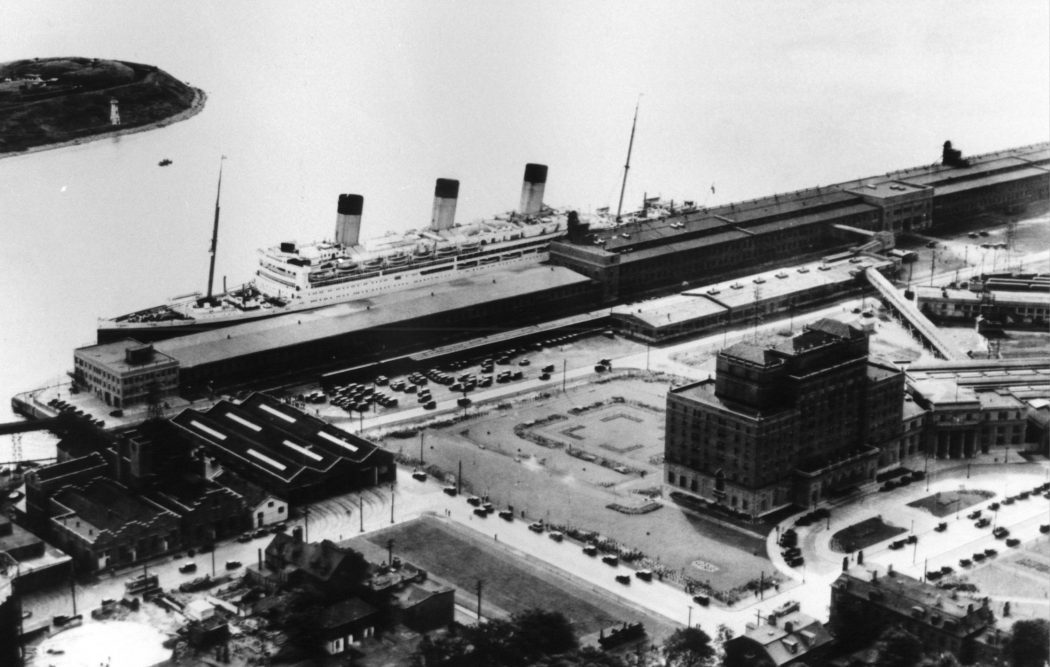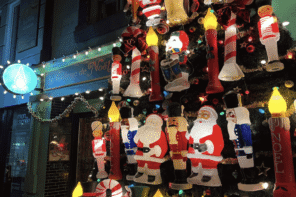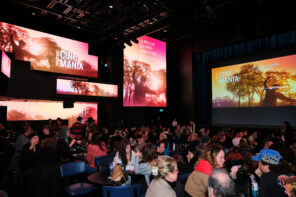A view of Pier 21 in Halifax, Nova Scotia was the first close-up many Italian immigrants had of Canada. Not very picturesque perhaps, with its serviceable brick buildings and expansive car parks, but then, most immigrants coming over in steamships after the Second World War did not uproot themselves for a glimpse of Canada’s landscapes. With the ordeal of being documented on the pier over, the newly-arrived often travelled by train further inland – of the near 300,000 Italians that came to Canada in the 50s and 60s, a majority settled in Toronto and Montreal. For those who chose the latter, Notre-Dame-de-la-Défense Parish (in the present borough of Rosemont-La-Petite-Patrie) became the site of their changed life, and of their community-building. Today, this stretch of the city bears the name “Little Italy.”
…many of the establishments in Little Italy, [serve] a dual function: it is at once a community centre for Italian-Montrealers and a place for the wider Montreal community to enjoy Italian culture.
Many of the original immigrants have passed away, and their children and grandchildren have made their homes elsewhere in Montreal. Yet there remains in Little Italy a band of individuals who set their roots in the 50s and have happily stayed put. You may find them three times a day on St. Laurent Boulevard at Caffè Italia enjoying a laugh and a healthy argument. Full disclosure: I know this only because I have often sipped a caffe latte at a table chosen specifically for the view it affords me of the corner that which these merry men occupy. My Italian is nonexistent, which is a shame, for it prevents me from understanding the taunts and banter they seem so easily to toss around. I am attracted to them for no other reason than this: they seem to know a good time, and theirs is retirement done right. I have long fought the impulse to go over and talk to them. A few days ago, I succumbed. I took my latte, pointed to an empty seat, and asked whether I could join. They indulged me.
I learnt that most of these men came over in the fifties, having left their hometowns all across Italy. Thus, they use a local variation of standard Italian (with its share of words borrowed from French and English) developed to account for the fact that they all spoke different dialects when they first arrived. If they find a shared space in this new language, Caffè Italia serves as the physical equivalent. They have been meeting here for decades, and many of them since it opened in 1956. They are well-known to the proprietors (family of the original owners), and no one would question their claim to the tables by the windows. No one, that is, except the young people that flood the café when Italy is playing in the World Cup. Then, they laugh, there are almost no spots left for the “old timers.” This well exemplifies the fact that Caffè Italia, like many of the establishments in Little Italy, serves a dual function: it is at once a community centre for Italian-Montrealers and a place for the wider Montreal community to enjoy Italian culture. They point to Milano’s, just next door, as another place that serves the Italian and broader Montreal communities simultaneously.
Milano’s takes up most of the block. A “fruiterie” established in 1954, it has now grown to such a size that you would be hard-pressed to find something not on offer. There are dozens of different olive oils and vinegars, rows of imported canned fruits and vegetables, all varieties of dried goods, meats, cheeses, Italian sweets and pastries, as well as household goods. I once picked up a pot of what I took to be a fancy chocolate face cream, only to discover it was fine imported hazelnut spread. My only defence is that the writing was all in Italian and it was stacked right next to the shampoos. In any case, I was not disappointed at the discovery. The point is, Milano’s has it all and it draws people from all parts of the island, not just the “old timers” — though they profit the most, perhaps, by making several trips a day.
So, wander Little Italy for the spirit, for the pork sandwiches, for the trattorias, for the art and history of Madonna Della Difesa. However, go first for the stories.
Listening to the conversation of these men, I think I was right to take a seat by them. In ten years’ time, their share of the noise in Caffè Italia will be claimed by others. With the passing of their hearty banter, so will the chance to hear their jokes, anecdotes, and their recollections of experiences we that may in years to come, hope to patch together from photographs in an archive.
So, wander Little Italy for the spirit, for the pork sandwiches, for the trattorias, for the art and history of Madonna Della Difesa. However, go first for the stories. Go because it is part of Montreal and because we can learn a lot about our city – and ourselves — by doing so. As you walk down the stretch of St. Laurent boulevard between St. Zotique and Jean Talon Street, notice the Italian shoe store, and the Italian bookstore, and Porchetta. Stop in at Milano’s and talk to someone about the salamis, or the olive oils, or the huge log of cheese sometimes on display. Spend an idle thirty minutes in Caffè Italia or sit in a pew of the first church built by and for the Italian community in Canada.
Yet notice also the Latin American grocery store, the French bakery, and the Spanish language school. And think about how this speaks to this city’s character. In Little Italy, cultures are shared and maintained, but they are transformed too. We too are part of that transformation. Above all, as you explore Little Italy, seize any opportunity to speak with people who knew and know a different Montreal — and Canada — than you.








